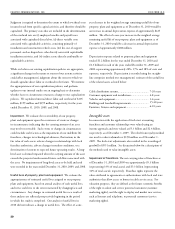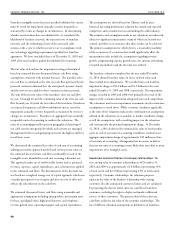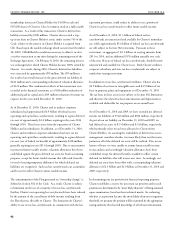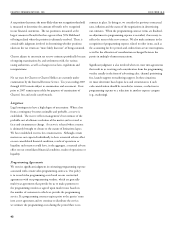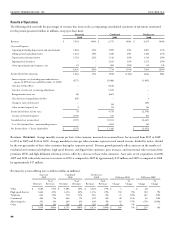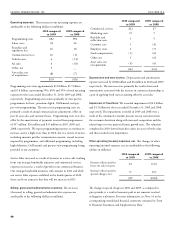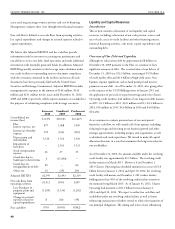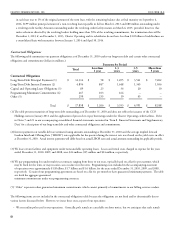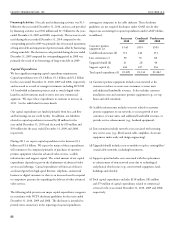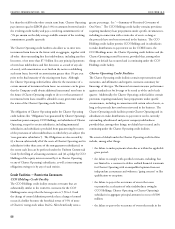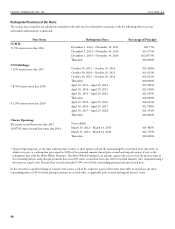Charter 2010 Annual Report Download - page 61
Download and view the complete annual report
Please find page 61 of the 2010 Charter annual report below. You can navigate through the pages in the report by either clicking on the pages listed below, or by using the keyword search tool below to find specific information within the annual report.
Other income (expense), net. e changes in other income
(expense), net are attributable to the following (dollars in millions):
2010 compared
to 2009
2009 compared
to 2008
Increases (decreases) in
investment income $(1) $2
Charge in value of
preferred stock 5 (3)
Other, net (1) 6
$3 $5
For more information, see Note 16 to the accompanying
consolidated financial statements contained in “Item 8. Financial
Statements and Supplementary Data.”
Income tax benet (expense). Income tax expense of $295 million
was recognized for the year ended December 31, 2010, primarily
through increases in deferred tax liabilities related to our investment
in Charter Holdco and certain of our indirect subsidiaries, in
addition to $8 million of current federal and state income tax
expense. Income tax expense for the year ended December 31, 2010
included $23 million related primarily to changes in estimates on
the 2009 tax provision, a $16 million expense related to asset sales
occurring in 2010 and a $69 million benefit related to the February
8, 2010 Charter Holdco partnership interest exchange.
Income tax benefit of $343 million for the year ended December 31,
2009 was realized primarily as a result of decreases in certain deferred
tax liabilities related to our investment in Charter Holdco and certain
of our subsidiaries. ese decreases are primarily attributable to the
impairment of franchises and fresh start accounting adjustments for
financial statement purposes and not for tax purposes. It included $8
million of current federal and state income tax expense.
Income tax benefit of $103 million for the year ended December
31, 2008 included $325 million of deferred tax benefit related to
the impairment of franchises and $2 million of deferred tax benefit
related to asset acquisitions and sales occurring in 2008. It included
$4 million of current federal and state income tax expense.
Net (income) loss – noncontrolling interest. Noncontrolling
interest represented the allocation of income to Mr. Allen’s previous
5.6% membership interests in CC VIII and the allocation of losses
to Mr. Allen’s noncontrolling interest in Charter Holdco. Mr. Allen
has subsequently transferred his CC VIII interest to Charter on the
Effective Date of the Plan. On February 8, 2010, Mr. Allen exercised
his remaining right to exchange Charter Holdco units for shares of
Charter Class A common stock after which Charter Holdco became
100% owned by Charter. See Notes 9 and 23 to our accompanying
consolidated financial statements contained in “Item 8. Financial
Statements and Supplementary Data.” e increase in losses allocated
is the result of the adoption on January 1, 2009 of new accounting
guidance which requires losses to be allocated to noncontrolling
interest even when such interest is in a deficit position.
Net income (loss). e impact to net income (loss) as a result of
impairment charges, loss on extinguishment of debt, reorganization
items and gains due to Plan effects and fresh start accounting, net of
tax, was to increase net loss by approximately $91 million in 2010,
increase net income by approximately $11.0 billion in 2009 and to
increase net loss in 2008 by approximately $1.2 billion.
We use certain measures that are not defined by GAAP to evaluate
various aspects of our business. Adjusted EBITDA and free cash
flow are non-GAAP financial measures and should be considered in
addition to, not as a substitute for, net income (loss) and net cash
flows from operating activities reported in accordance with GAAP.
ese terms, as defined by us, may not be comparable to similarly
titled measures used by other companies. Adjusted EBITDA and free
cash flow are reconciled to consolidated net income (loss) and net
cash flows from operating activities, respectively, below.
Adjusted EBITDA is defined as consolidated net income (loss) plus
net interest expense, income taxes, depreciation and amortization,
gains realized due to Plan effects and fresh start accounting
adjustments, reorganization items, impairment of franchises, stock
compensation expense, change in value of derivatives, gain (loss)
on extinguishment of debt and other operating expenses, such as
special charges and loss on sale or retirement of assets. As such, it
eliminates the significant non-cash depreciation and amortization
expense that results from the capital-intensive nature of our
businesses as well as other non-cash or non-recurring items, and is
unaffected by our capital structure or investment activities. Adjusted
EBITDA is used by management and Charter’s board of directors
to evaluate the performance of our business. For this reason, it is a
significant component of Charter’s annual incentive compensation
program. However, this measure is limited in that it does not reflect
the periodic costs of certain capitalized tangible and intangible



